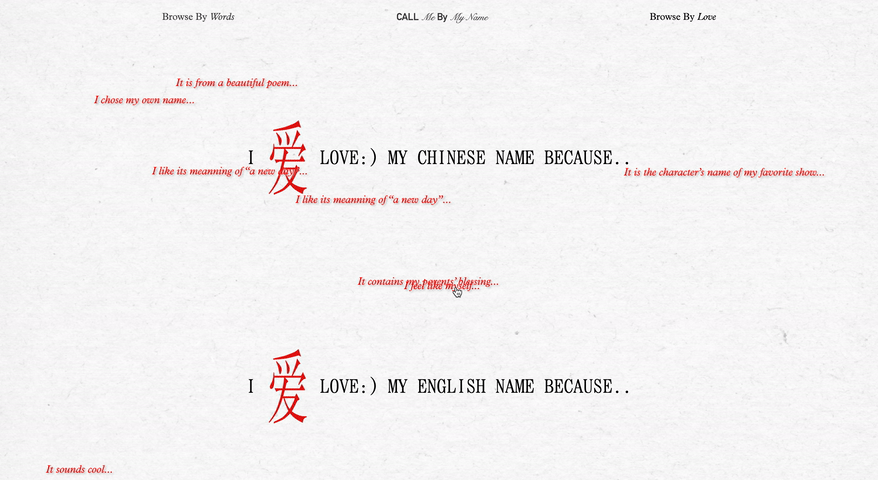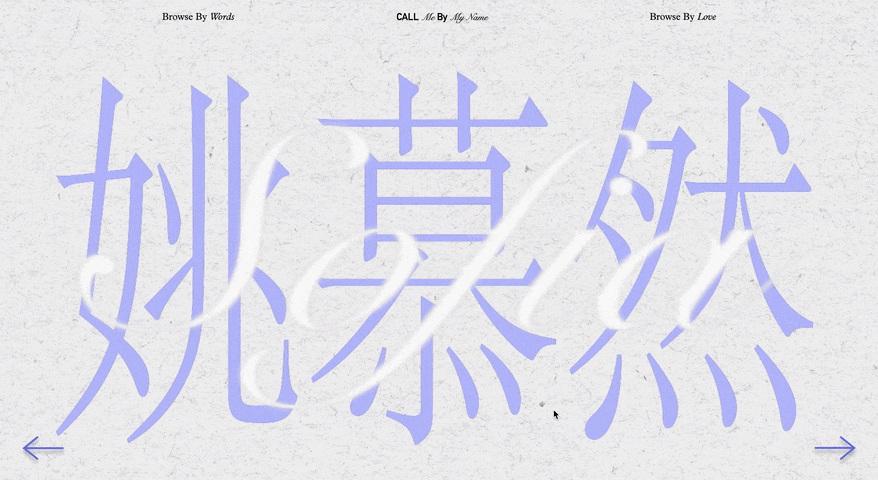“Call Me By My Name”
Degree Project
Degree Project
The project “CALL ME BY MY NAME” explores the complex feelings Chinese international students have about their anglicized names and their sense of identity. Through this project, I aim to share these stories with English-speaking audiences, offering insight into the nuanced relationship between names, culture, and self-perception.
2022
Last year, I came across a video on Chinese social media titled “I Decided Not To Learn English Anymore.” In it, a Chinese Harvard student shared her language-learning journey and the challenges she faced while trying to adapt to American society. In the video, she mentioned how her primary school teacher randomly assigned English names to students. Surprisingly, I had the exact same experience—my English name, “Sally,” was also randomly given to me by my English teacher. She got “Wency,” and I got “Sally.”
I stopped using “Sally” during my first year of college. Before college, I felt like it is just a code name I only used occasionally. But in an english speaking environment, “Sally” became my primary name, and suddenly, I realized I wasn’t “Sally” and probably never should be. Looking back now, I wonder: why do we need an English name to start in the first place?
Inspired by this video, I began reflecting on the relationship between our Chinese names and English names. As international students, many of us have or have had multiple names in different language environments. How do people feel about their names? Which name do they identify with? Who gave them their English names? To explore these questions, I created a questionnaire and started collecting stories from Chinese international students studying in the U.S.

#1 Love & Not Love Zine
While collecting stories, I discovered an interesting contrast that many people cherish their Chinese names and the meaningful wishes behind them, while others feel burdened by these wishes or dislike the literal meanings of their names. To reflect these differing perspectives, I created two zines, each dedicated to one of these two types of stories.
For the covers, I used the Chinese character for “love” (爱) as the main visual element. For the zine featuring stories of people who dislike their names, I modified the character by inserting the word “don’t” (不) inside it. This visual alteration symbolizes the complex and sometimes conflicting emotions people have toward their names.
For the covers, I used the Chinese character for “love” (爱) as the main visual element. For the zine featuring stories of people who dislike their names, I modified the character by inserting the word “don’t” (不) inside it. This visual alteration symbolizes the complex and sometimes conflicting emotions people have toward their names.



#2 shell book
This shell zine focusing on the literal interpretations of people’s names. For example, one person’s family name means “memorize,” and her parents paired it with the word “ice” for the first name, because they wished her to always remember the snow and ice of their hometown.
I use seashells as the material for this zine because I see these stories as treasures, much like seashells that have traveled across vast stretches of time and space to reach us. I hope readers can feel the same sense of preciousness while flipping pages.
I use seashells as the material for this zine because I see these stories as treasures, much like seashells that have traveled across vast stretches of time and space to reach us. I hope readers can feel the same sense of preciousness while flipping pages.

The official I-20 Form sample

#3 Fake I-20 form
An I-20 form is an official government document that certifies a person's eligibility to apply for an F-1 student visa. For this project, I reimagined the I-20 by replacing its original content with the name stories i collected. Viewers are invited to engage with these stories by signing their names, creating an interactive experience that connects them to the narratives.




#4 Archive Webiste
shitonglyu.github.io/call-me-by-my-name/browse-by-words.html
shitonglyu.github.io/call-me-by-my-name/browse-by-words.html
To better share and document these name stories, I designed a website that allows users to explore these narratives through interactive features. The homepage is filled with names, and when you hover over them, the signatures of each person appear. Clicking on a name takes you to their individual page, where you can read their stories and learn the correct pronunciation of their names.